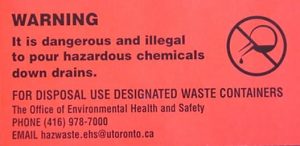Waste materials must be labeled and packaged in a manner that will allow them to be stored or transported without the danger of spillage, explosion or hazardous vapours escaping. Consult Section 5 for further requirements for specific hazardous wastes.
- The waste generator bears the primary responsibility for proper packaging and labeling.
- All safety precautions required for handling and storage of the hazardous material must also be observed with the subsequently generated wastes.
Any hazardous waste that is improperly packaged or labeled will not be removed.
4.1 Packaging
- The researcher is responsible for providing waste containers for the laboratory generating chemical waste, although 20 litre green plastic pails are available in some situations. The Environmental Protection Services provides containers to researchers generating radioactive and biological wastes. A limited number of 200 litre drums are available to researchers for chemical wastes such as waste oils.
- To avoid explosions, fires or spills, incompatible mixtures must not be mixed in a single waste container.
- Chemical liquid waste containers should only be filled to approximately 75% capacity to allow for vapour expansion and to reduce the potential for spills occurring from moving overfilled containers.
- Container material must be compatible with the stored hazardous waste (e.g., sharps must be in puncture-resistant containers, hydrofluoric acid cannot be stored in glass containers).
- Wastes must not be packaged in containers that improperly identify other nonexisting hazards. For example, chemical wastes cannot be packaged in biohazard bags if no biohazard is present.
- Non-hazardous waste must not be placed in hazardous waste containers, contact Caretaking or Recycling for information on disposing of non-hazardous waste.. Disposing of hazardous waste materials is very expensive. It is the responsibility of each generator to ensure that wastes are properly segregated for disposal.
4.2 Labeling
Waste materials must be labeled in a manner that will allow the hazards to be clearly and accurately identified.
- Maintain an accurate inventory of the waste materials being added to the waste containers using the appropriate waste labels provided by the Environmental Protection Services (EPS). Waste labels for chemical, biological and radioactive wastes are available free of charge from the Environmental Protection Services.
- Labels for hazardous waste containers must be attached to the packaging.
- Specific generic names of the components in the container must be listed. No abbreviations, acronyms or trade mark names are to be used. Vague categories (e.g., solvent waste) are not acceptable. Contact information such as building name, room number and individual producing the waste or in the case of biological and radioactive waste, a permit number must be listed.
| PLEASE NOTE:The Environmental Protection Services staff responsible for removing hazardous wastes from buildings rely on properly labeled packaging. Their safety is dependent on the accurate identification of the contents and the labeling of the waste containers. |
- Should an unlabeled container be discovered in the laboratory, and its contents are not known, contact Environmental Health and Safety at 416.978.7000 or email <eps.hazdisposal@utoronto.ca>.
4.3 Storage
- Containers must be in good condition and should remain closed unless waste is being added.
- Hazardous waste must be stored safely prior to removal from the laboratory and should not be allowed to accumulate.
- Materials with special storage requirements include organic peroxides, PCBs (polychlorinated biphenyls), non returnable gas cylinders and explosives. Before disposing of these materials, contact Environmental Protection Services at 416.978.7000 or email eps.hazdisposal@utoronto.ca.
- Liquid hazardous waste containers stored in laboratories should be periodically inspected for leaks.
- Dispose of aging containers promptly.
4.4 Sewer Disposal
- Hazardous liquids must not be flushed down drains as a method of disposal. This practice is illegal in accordance with a City of Toronto Bylaw and provincial legislation and may lead to dangerous reactions, damage to the drainage system as well as creating a potential hazard for Trades Personnel working on the system. Labels are available free of charge to display over sink areas warning of the danger in pouring hazardous chemicals down the drains. Contact the Environmental Protection Services at 416.978.7000. See Figure 1 for an example of a drain label.
Figure 1 : Example of Drain Label
